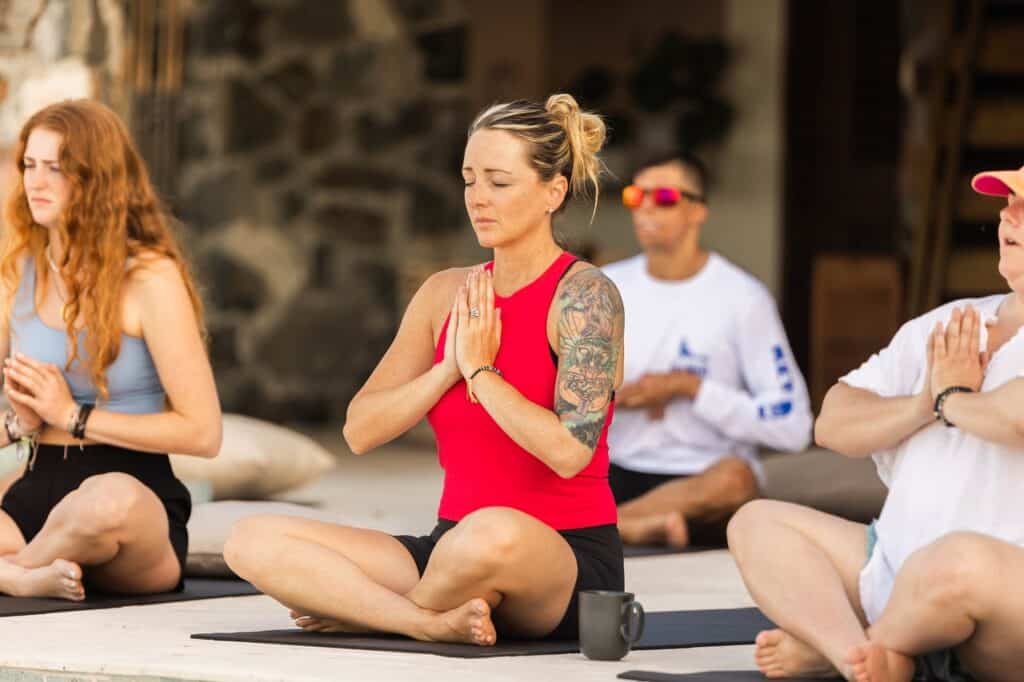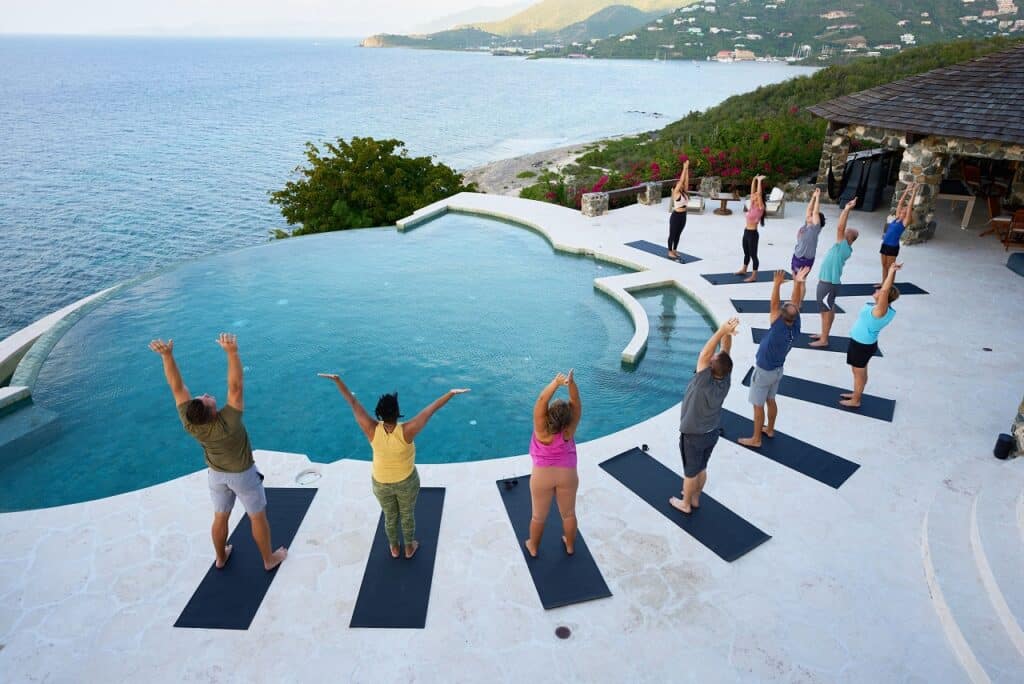You can get the most out of a mindfulness meditation retreat by finding an environment that provides a sanctuary away from the noise of modern life. Mindfulness meditation retreats are available worldwide. These retreat centers offer a nourishing and invaluable escape from everyday life distractions.
In-person retreat centers for mindfulness aim to help participants gain a deeper sense of awareness. An online retreat can also be useful for individuals unable to travel to an in-person retreat center. The following tips will help you get the most out of your mindfulness journey.
1. Find a Retreat Center Philosophy that Resonates with You
To get the most out of a mindfulness retreat, you should ensure that the retreat center’s philosophy aligns with your life goals. Choosing the right mindfulness retreat will depend on the mindfulness and self-care activities you enjoy. Many mindfulness retreats incorporate activities such as:
- Walking meditation
- Yoga classes
- Mindful movement
- Mindful eating
- Loving-kindness meditation
- Contemplative art
Other common mindfulness retreat center themes and philosophies include:
- Yoga teacher training retreats
- Yoga and meditation retreats
- Spa and wellness retreats
- Digital detox retreats
- Spiritual retreats
- Silent retreats
- Mental wellness retreats
Silent retreats offer an incredible opportunity to immerse yourself in guided exercises in serene silence. Attending our Elevate Presence Summit at The Aerial, BVI, a health and wellness resort, gives you the opportunity to experience a semi-silent retreat. Before booking a mindfulness retreat, make sure the theme and philosophy resonate with your inner self.
2. Go with an Open Mind
Attending a mindfulness retreat, whether for the first time or the tenth, requires self-compassion and an open mind. A willingness to be vulnerable and receptive will also help you get the most out of the experience. One of the best ways to practice having an open mind is to consciously choose a mindfulness retreat that resonates with your soul and, from there, trust in the process.
Every individual will experience their mindfulness journey in their own way. For this reason, it’s important to stay open to new experiences that may or may not feel comfortable. Self-exploration while on a mindfulness retreat will be challenging; an open mind will ensure you get the most out of the ebbs and flows of your time there.

3. Take Time to Acclimate
It is important to go into a mindfulness retreat with an open mind, but it is also crucial to allow yourself enough time to adjust to the process. Likewise, removing yourself from daily life and dropping yourself right into a silent meditation retreat can initially feel overwhelming.
The benefits of mindfulness-based stress reduction are well documented. A mindfulness practice can be effective in treating illnesses such as depression, anxiety, and chronic pain. However, don’t be discouraged if you don’t see the benefits of mindfulness techniques overnight. By approaching your mindfulness journey with an open and patient mindset, you may notice a profound shift by the end of the retreat.

4. Disconnect to Reconnect
A mindfulness retreat is a unique opportunity to disconnect from the noise of everyday life and reconnect with your inner calm. For instance, many silent retreats incorporating silent meditation practices muffle outside noise so you can focus on deep healing. Silent retreats are also a chance to connect with your body and cultivate a profound sense of physical peace.
Many mindfulness silent retreat centers will require that you unplug from your everyday technologies, such as your phone or computer, especially if you go on a digital detox retreat. This kind of retreat allows you to be completely present in the moment and helps you reconnect with the simpler things in life.

5. Heal with Nourishing Food and Drink
A great aspect of most mindfulness retreats is that they offer delicious food that heals. For instance, The Aerial, BVI offers a bountiful menu of pescatarian-forward food prepared using locally sourced, high-quality, and nourishing ingredients.
Depending on where the mindfulness retreat center is located, multi-day retreats will likely provide participants with a healthy food selection. Participating in mindfulness exercises every day can be both exciting and exhausting. Nourishing yourself with meals that help you feel your best is essential for getting the most out of your mindfulness retreat experience.

6. Fill Your Day with Feel-Good Activities
To get the most out of your mindfulness retreat, fill your day with activities that make you feel great. Some retreats may allow you to tailor your retreat to your specific needs and will offer plenty of extracurricular activities that support well-being.
Some common feel-good activities offered at mindful or health and wellness retreats include:
- Yoga and meditation classes
- Holistic spa services
- Watersports such as snorkeling or paddleboarding
- Land activities such as horseback riding or equine therapy
- Art and writing therapies
- Cooking classes
- Volunteering opportunities
When you choose a mindfulness retreat, it’s best to check out the additional amenities and activities the retreat space offers. Having a bountiful selection of healing modalities and recreational activities will add to the joy of your retreat experience.

7. Find a Supportive Network
A network that supports you while you are on your mindfulness journey can help you feel safe to dig deep into your healing. A supportive network looks different to everyone. For example, maybe you have a strong relationship with your mother or father and want to involve them in your journey toward greater mindfulness. In contrast, perhaps you have a supportive friend with whom you can check in before, during, and after the retreat.
Building a supportive network of like-minded people while on your retreat will also nurture and sustain you on the path toward greater self-awareness. Ultimately, creating a mentoring system will enrich your retreat experience and keep you accountable long after the retreat has ended.
8. Have a Safe Place to Return Home to
When you return home from an immersive meditation retreat, you should have a safe place to transition back into real life. For example, you could ask for more time off of work once the retreat ends to adjust to life outside the retreat. This will allow you to incorporate your new mindfulness strategies into your everyday life.
Additionally, having a safe place to return home to could include the following:
- Journaling about your retreat experience
- Checking in with your support network
- Stocking up on food that continues to support your nutrition goals
- Incorporating mindful techniques into everyday living
- Following up with your retreat teachers
- Researching other retreat opportunities for the future
Having a sacred space to return to after a retreat is essential for getting the most out of your mindfulness journey. Aligning your new mindful practice with your life routine can help you maintain the clarity and calm you cultivated while away.
A Life-Changing Journey Awaits
One of the best ways to get the most out of a mindfulness retreat is to find an atmosphere that nurtures your mind and body. Look for a retreat space with plenty of self-care activities and experiences that will help you on your mindfulness journey.
Activities like yoga, massage, and guided meditation improve your mental clarity and enrich your overall retreat experience. An open mind and willingness to pursue deep inner healing will also help you make the most of this life-changing experience. Then, implementing a mindfulness meditation practice at home will help you benefit long after the retreat ends.